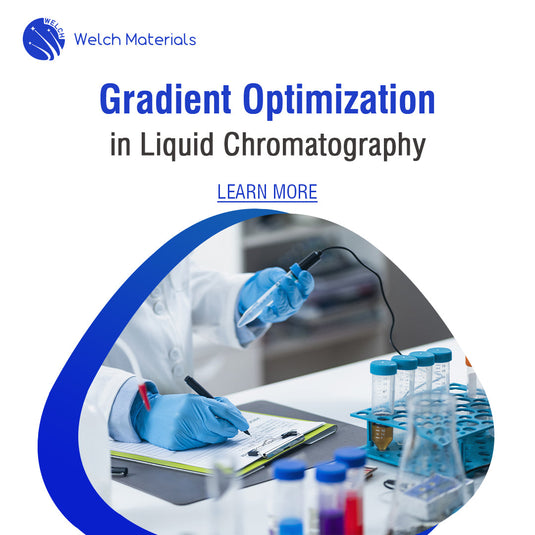Knowledge Base
-
![[Readers Insight] Stop Being a Lab Robot: Mastering National Standards in HPLC Analysis](//www.welch-us.com/cdn/shop/articles/lab-robot-1080_535x.webp?v=1761628398)
[Readers Insight] Stop Being a Lab Robot: Mastering National Standards in HPLC Analysis
Executing HPLC methods mechanically limits your potential as a chromatographer. This article breaks down an example method to show how understanding analyte chemistry, matrix effects, and solvent roles empowers you to troubleshoot and optimize, not just follow. -

Advanchrom HIC-Butyl FAQ: Linker Stability, Sample Handling, Column Treatment…
This Q&A recap from our May 22 webinar covers essential questions on ADC analysis using Advanchrom HIC-Butyl columns, with expanded expert responses offering deeper insights into best practices and technical considerations. -

Welch Columns in the Spotlight: Shining Stars of the 2025 Edition of the Chinese Pharmacopoeia
Discover Welch HPLC columns featured in the 2025 Chinese Pharmacopoeia, with applications and specs for pharmaceutical analysis. -
![[Readers Insight] How to Quickly Establish Robust HPLC Analytical Methods: A 5-Step Expert Guide](//www.welch-us.com/cdn/shop/articles/webp_03042904-1b2e-4fcd-8803-6dc1c58818a8_535x.webp?v=1765523545)
[Readers Insight] How to Quickly Establish Robust HPLC Analytical Methods: A 5-Step Expert Guide
This practical article guides new chromatographers through five essential steps to build robust HPLC methods: structural analysis, solvent selection, signal enhancement, elution optimization, and method validation. -

Pursuing Excellence in Pharmaceutical Quality Control: Best Practices and Insights for Laboratories
In this article, one of Welch’s long-term customer shares their practices and insights on pharmaceutical laboratory quality control in both HPLC and GC, along with their firsthand experience of Welch’s HPLC columns. -
![[Readers Insight] Why “Peak Area” is Used for Quantification in Chromatography](//www.welch-us.com/cdn/shop/articles/1080-peak-area_535x.webp?v=1761629420)
[Readers Insight] Why “Peak Area” is Used for Quantification in Chromatography
Peak area is the preferred metric for quantification in chromatography due to its consistency across variable peak shapes and resistance to signal distortion. Unlike peak height or volume, it offers reliable integration even with minor peak deformation or interference, making it the most robust choice in routine analysis. -

Best Practices for Mobile Phases in HPLC: Preparation, Use, and Storage
Proper preparation, handling, and storage of HPLC mobile phases are essential for achieving accurate, consistent results. This article outlines key considerations for selecting solvents, preparing mobile phases, and avoiding common pitfalls that can affect chromatographic performance and instrument longevity. -

HPLC Content Determination Method Validation: A Comprehensive Guide
This guide provides a detailed overview of HPLC method validation for content determination, highlighting key procedures, technical considerations, and common pitfalls to ensure accurate and reliable results. -
![[Readers Insight] Chromatographic Separation Strategies for Multi-Component Analysis](//www.welch-us.com/cdn/shop/articles/1080-multi-component_535x.jpg?v=1761629958)
[Readers Insight] Chromatographic Separation Strategies for Multi-Component Analysis
Mass spectrometry simplifies multi-component analysis, but chromatographic separation remains essential for challenging cases. This article explores enhancements in gradient elution, column selection, temperature, flow rate, and mobile phase composition for separation efficiency and resolution. -

Gradient Optimization in Liquid Chromatography
In this article, we explore key considerations in gradient method development, and witness how optimizing gradient elution in HPLC is key to achieving efficient separation through a real-world case study. -

Mastering the HPLC Autosampler: This Guide is All You Need
The HPLC autosampler is a key component for precise and efficient chromatography. This guide covers autosampler designs, injection methods, and essential maintenance practices to ensure accurate and reliable results. -

A Comprehensive Guide to Guard Columns and Pre-Columns
This guide explores key differences, functions, replacement guidelines, and selection criteria of guard columns and pre-columns (in-line filters) to help ensure optimal chromatographic performance and extended column lifespan.






![[Readers Insight] Stop Being a Lab Robot: Mastering National Standards in HPLC Analysis](http://www.welch-us.com/cdn/shop/articles/lab-robot-1080_535x.webp?v=1761628398)


![[Readers Insight] How to Quickly Establish Robust HPLC Analytical Methods: A 5-Step Expert Guide](http://www.welch-us.com/cdn/shop/articles/webp_03042904-1b2e-4fcd-8803-6dc1c58818a8_535x.webp?v=1765523545)

![[Readers Insight] Why “Peak Area” is Used for Quantification in Chromatography](http://www.welch-us.com/cdn/shop/articles/1080-peak-area_535x.webp?v=1761629420)


![[Readers Insight] Chromatographic Separation Strategies for Multi-Component Analysis](http://www.welch-us.com/cdn/shop/articles/1080-multi-component_535x.jpg?v=1761629958)


